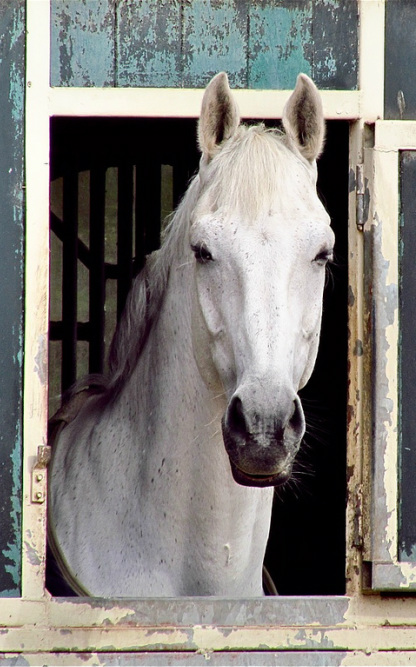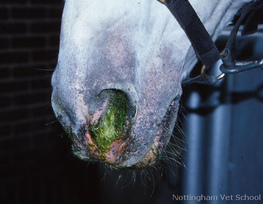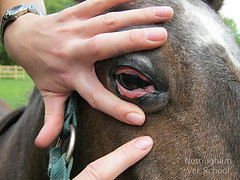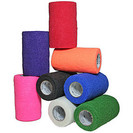Signs of Good Health
|
|
Temperature (99.5-101.5°F):
Lubricate the end with vaseline and, standing to one side, insert the thermometer so that it's held at a slight angle against the wall of the rectum.
Pulse (30-42 bpm):
Foals' pulse rates will be between 50-100 beats per minute.
- Use a stethoscope, pressing it firmly against the horse's girth area (just behind the left elbow), and listen for the heart beat. Count the beats for fifteen seconds and then multiply by four.
- Press two fingers against the facial artery, which is located on the inside edge of the horse's lower jaw.
- Pulse can also be found in the radial artery, inside the foreleg.
Respiration (3-16 bpm):
The horse must be standing still, at rest. Watch the rise and fall of their flanks, counting either one or the either (the complete rise and fall is one breath).
* Capillary Refill Time (approximately 1.5 seconds)
Press your thumb into their gums for a few seconds, long enough to blanch the area, and then count the seconds it takes for color to return to that area. A delay of 2-3 seconds can signal mild dehydration. However, longer delays indicate reduced blood circulation due to blood loss, more severe dehydration or decreased blood pressure (eg. shock).
Abnormal mucous membranes -
pale: anemia
dark red and dry: fever
tacky and dry: dehydration
yellow: possible liver issue/failure
red with blue/purple tinge: pneumonia
Check for dehydration too...
Pinch the skin on your horses neck or point of shoulder and watch how quickly it returns to normal. If a horse is dehydrated, the pinched skin will tent and remain folded for a few seconds.
What to keep in your horse's first aid kit:
|
Extra tips and tricks
- Diapers make great temporary bandages or poultice wraps. - I personally keep both mineral oil and Swat in my medicine cabinet, instead of Vaseline. The mineral oil serves as a good lubricant for both the thermometer and in some colic cases, while the Swat is both an ointment as well as a fly repellent. - In addition to a wound ointment, I suggest stocking a wound spray, in order to disinfect sensitive/untouchable areas. - I recommend including a bottle of Wonder Dust in your first aid kit because it can stop bleeding and prevent the development of proud flesh. - Duct tape definitely comes in handy. It can be used to waterproof leg bandages or temporarily wrapped around a hoof when a shoe has been tossed to prevent chips and keep it clean/dry. - Attach a piece of string to your thermometer, so you don't lose it in your horse. - If you're confident in your abilities to administer medication to your horse, you might consider stocking Banamine (provides some relief during colic) and Acepromazine (a sedative) for emergencies. However, even if you have these medications available, always consult your vet before administering them. - Having a flashlight can be helpful, if you have to examine the horse's eye or a wound at night. - Writing the expiration date on a piece of tape and placing it on the front or top of each item in your medicine cabinet, can help you keep things organized and up to date. - Keeping a jar of peanut butter or individual cups of applesauce around can prove useful when trying to give your horse Bute. |
Rectal thermometer and a stethoscope. In order to take vitals, as described above. Sterile gauze strips (assortment of sizes). To clean and cover minor cuts and wounds Surgical gloves. Keeps your hands clean and prevents wound contamination. Cotton rolls. Useful for applying pressure bandages or dressings for more severe cuts and scrapes. (be careful not to apply directly to the wound, as it can stick. Gauze rolls are better for this). Wound cleaner (recommend stocking both Hydrogen Peroxide and Iodine). Hydrogen Peroxide is great for cleaning fresh wounds and will help prevent tetnus. It's also useful with thrush. However, do not use this after the initial cleaning, as it can inhibit the healing process. An antiseptic scrub like Betadine or Nolvasan can be used to re-clean the wound when changing dressings. Bandages (you should have both self-adhesive and non, such as Vetrap and a clean set of polo wraps). Useful for protecting wounds, supporting muscles and even holding an ice/heat pack to your horse. Antibiotic Ointment. Prevents infection and some types can provide relief by numbing the area or simply keeping it moist. Epson salts. Great for drawing out infection. Most commonly used on abscessed feet, but beneficial for other cuts and scrapes too Vaseline. Helpful for lubricating the thermometer and can be used on dry heels as well as to prevent chaffing. Saline solution. Bottles with squirt nozzles are best for flushing out irritated or injured eyes. Phenylbutazone (a.k.a "Bute"). An anti-inflammatory and pain killer. Available as a paste, pill, or powder. Extra towels. Can be used to wash a wound or held against a bleeding one. Medicated shampoo. Can be very useful for a variety or skin issues. Farrier tools. Helpful if you need to remove a shoe. Tweezers. To remove splinters, burrs, etc. A pair of safety scissors. Needed to cut bandaging. Medical adhesive-tape. For fastening bandages. Cold Packs Instant ones are best |





